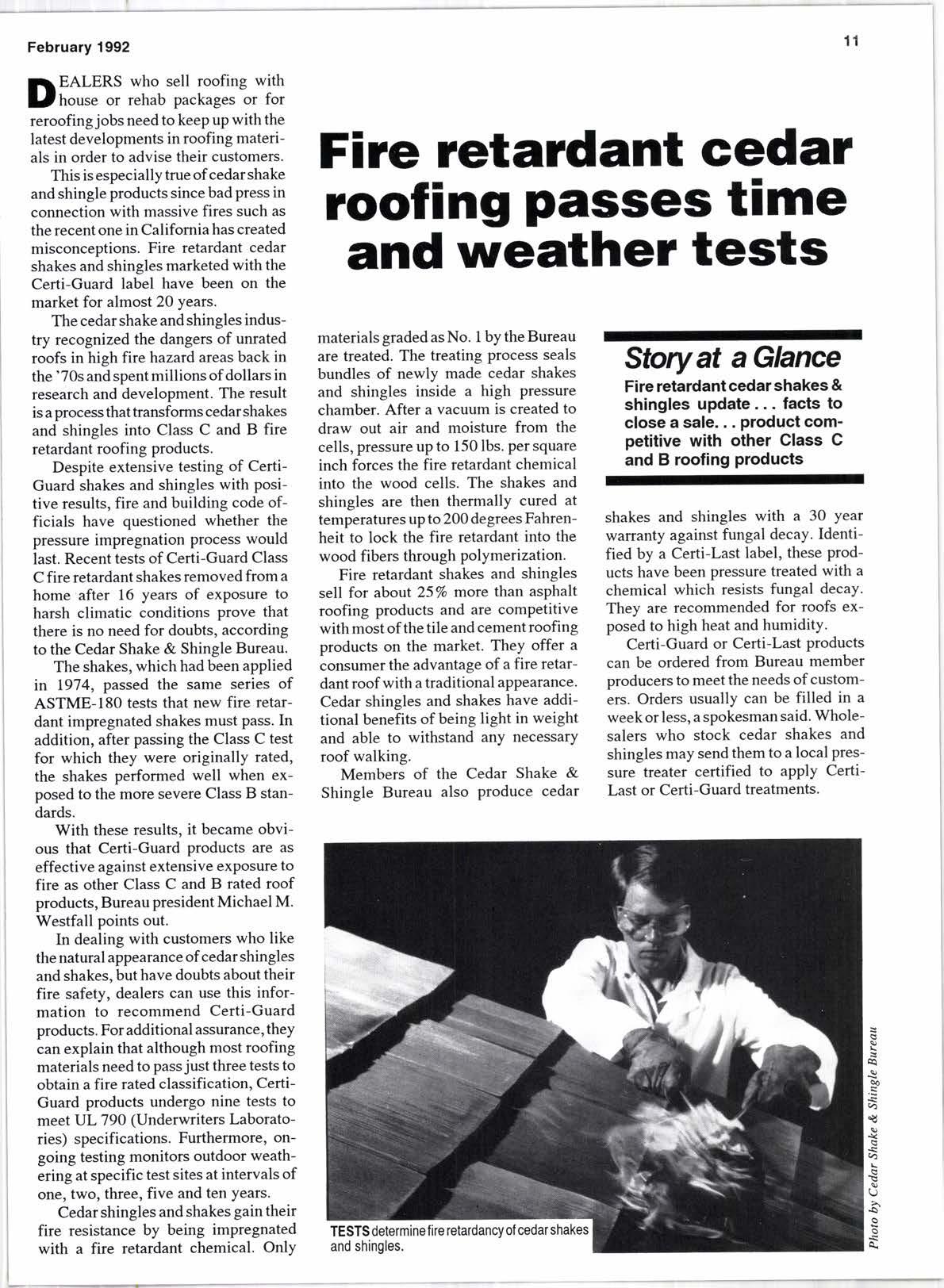
3 minute read
Multi'rtri I I ion dol lar cedat promotion
f f f ESTERN red cedar distributors
!f and dealers across the country are applauding a multi-million dollar marketing program aimed at increasing demand for cedar lumber products inthe United States. Projected as a four year program, the promotion is budgeted at more than $5 million.
"Certainly it's a good idea," said Ben Cederbloom, sales manager, M. F. Tomsick Lumber Co., Kennewick, Wa. "Any advertising is helpful."
He noted a particular need for promotion in areas turned off from cedar by lowerquality products shippedthere 15 ormore years ago. "They gotburned and, as a result, some areas have been out of the cedar market ever since," he said.
"But the quality is a lot better now, with much more stringent grading and quality control, particularly in the tight knot products," Cederbloom added.
Other dealers are equally enthusiastic that the exceptional drnability, light weight, remarkable color and texture plus the fine straight grain and unique insulating cellular structure of westem red cedar will be publicized. Because of scaled back promotions and advertising in recent years, many younger contractors. architects and consumers are unaware of its benefits, some say.
Westemred cedar lumber manufacturers in the Pacific Northwest and westem Canada are joining in the campaign which began Jan. 1. Spearheaded by the Westem Red Cedar Lumber Association, which includes producers in both the United States and Canada, the promotional program will emanate from offices in Portland, Or., and
SlDlNG, decking and boards in western red cedar clear and common grades are targeted lor increased sales in cooperative marketing promotion by U.S., Canadian ceda producers, and the Canadian government.
Vancouver, B.C. Field offices also will be established to serve cedarmarkets in midwest and southern cities.
Expanded marketing efforts will be funded by the cedar industry with supplementary matching funds from the Western Economic Diversification Office of the Government of Canada. Western Red Cedar Lumber Association member mills produce nearly 75% of the westem red cedar lumberused in the U.S. each year.
"This program represents a strong commitment by cedarmanufacturers to provide essential marketing support for the products we make," WRCLA president Robert Landucci explained. "Not only will we target major customer groups in our marketing, we will also develop materials to assist distributors in selling cedar products."
Promotional activities will focus on up-market residential housing and shess the quality, durability and environmentally friendly aspects of natural western red cedar products compared to vinyl, aluminum and chemically treated products.
Storyat aGlane
U.S. and Canadians join in marketing program... midwest and southern field offices to open ... beefed up advertising, literature, semF nars, promotion events for siding, decking and boards in clear and common grades.
The campaign will include advertising in major trade and consumer publi cations; literature and video tapes on cedar lumber products; regular and special publicity offerings for local and regional media; display materials for exhibitions; seminars on how to properly select, install and maintain cedar; and a cedar design awards competition co-sponsored with the American Institute of Architects.
Cedar products targeted for specific marketing activities include siding, decking and boardsin clear and common grades.
;EALERS who sell roofing with llhouse or rehab packages or for reroofing jobs need to keep up with the latest developments in roofing materials in order to advise their customers.
This is especially true of cedar shake and shingle products since bad press in connection with massive fires such as the recent one in California has created misconceptions. Fire retardant cedar shakes and shingles marketed with the Certi-Guard label have been on the market for almost 20 years.
The cedarshake and shingles industry recognized the dangers of unrated roofs in high fire hazard areas back in the '70s and spent millions of dollars in research and development. The result is aprocess thattransforms cedarshakes and shingles into Class C and B fire retardant roofing products.

Despite extensive testing of CertiGuard shakes and shingles with positive results, fire and building code officials have questioned whether the pressure impregnation process would last. Recent tests of Certi-Guard Class C fire retardant shakes removed from a home after 16 years of exposure to harsh climatic conditions prove that there is no need for doubts, according to the Cedar Shake & Shingle Bureau.
The shakes, which had been applied in 1974, passed the same series of ASTME-180 tests that new fire retardant impregnated shakes must pass. In addition, after passing the Class C test for which they were originally rated, the shakes performed well when exposed to the more severe Class B standards.
With these results, it became obvious that Certi-Guard products are as effective against extensive exposure to fire as other Class C and B rated roof products, Bureau president Michael M. Westfall points out.
In dealing with customers who like thenatural appearance of cedarshingles and shakes, but have doubts about their fire safety, dealers can use this information to recommend Certi-Guard products. For additional assurance, they can explain that although most roofing materials need to pass just three tests to obtain a fire rated classification. CertiGuard products undergo nine tests to meet UL 790 (Underwriters Laboratories) specifications. Furthermore, ongoing testing monitors outdoor weathering at specific test sites at intervals of one, two, three, five and ten years.
Cedar shingles and shakes gain their fire resistance by being impregnated with a fire retardant chemical. Only










